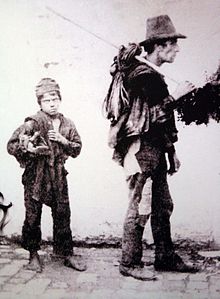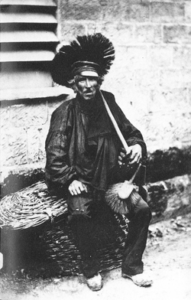by Guest Blogger H. Linn Murphy
 Recently I was doing research on chimney sweeps for a book I was writing called HEART OF FIRE. It turns out the life of a chimney sweep (and especially that of his poor Climbing Boy or girl) isn’t at all like that of the glorified happy-go-lucky, slightly bespattered-yet-still-dapper man in Mary Poppins. Sweeping was hazardous, demeaning, and low-paying. Chimney sweeps often had to do double duty cleaning out privies, a job known as a “nightman.”
Recently I was doing research on chimney sweeps for a book I was writing called HEART OF FIRE. It turns out the life of a chimney sweep (and especially that of his poor Climbing Boy or girl) isn’t at all like that of the glorified happy-go-lucky, slightly bespattered-yet-still-dapper man in Mary Poppins. Sweeping was hazardous, demeaning, and low-paying. Chimney sweeps often had to do double duty cleaning out privies, a job known as a “nightman.”
Before the Great Fire of London, which happened on September 2nd through 5th, 1666, Climbing Boys rarely climbed chimneys. Afterwards, people were more worried about the layer of creosote and soot starting fires, so the smaller boys were used. In England, another great increase in the use of small children as Climbing Boys occurred after 1773 in an actual attempt to be more humanitarian. It was found that children were not surviving well in workhouses or orphanages. In many, even surviving for a year was difficult. Parliament passed an act which said children could spend no more than three weeks in a workhouse. In an effort to increase their chances for survival, more children were apprenticed out to occupations such as chimney sweeping and other jobs which needed cheap, expendable labor.
Italy, Belgium, and France all used Climbing Boys as well. Germans did not, as the Sweeps belonged to Sweep Guilds. Scotland did not allow climbing either. The Sweep used bundles of rags or balls on chains or ropes dropped down from the top.
Everything was taxed in 17th century Britain, along with hearths. The size of the house and number of chimneys shot the tax sky high. Which meant that builders of new homes or new chimneys connected new flues with the existing chimney, making for a veritable and truly dangerous maze of pitch black, cramped tunnels which jigged and bent around obstructions.
As the use of coal for household fuel became more prevalent, Sweeps became more and more widely used. Coal dust (creosote) collected in the chimneys in greater quantities and could ignite and cause fires in the predominantly wooden structures. Soot was valuable and sold to farmers for fertilizer. Because the Sweep was generally too large to climb the chimneys, he usually employed two to twenty Climbing Boys, depending on how many of them he could keep alive.
The parish generally paid a Master Sweep to employ as many four to thirteen year old destitute children and orphans as possible. Most often they started around the age of six, as before that, the children were often too weak to climb the often 400 feet to the tops of high chimneys. The children mainly signed letters of indenture, which forced them to work for the Sweep until they had reached their majority (adulthood). This took the children off the hands of the parish. The Sweep was even allowed to buy children from poor parents or kidnap homeless waifs from the street to use.
The Master Sweep’s job was to teach the craft and all its secrets, take the child to church, desist in sending the child into a chimney currently on fire, and offer a second change of clothing and a weekly bath. There were, of course slackers who did not follow these rules. Baths were often much more rare than weekly. One sweep only bathed his apprentices on Christmas, Whitsun (just after Easter), and Goosefair (early October). Many only bathed them once monthly or bi-yearly, and that in the frigid river. They were seldom fed well, to keep them small enough to climb the chimneys. Often the child was so hungry he had to beg for food from the clients. Since the Sweep was to provide room and board, the Climbing Boy wasn’t paid and there was no limit to the hours a boy or girl worked. If the child received clothing from a client, dishonest Sweeps might take the clothing to sell for more money.
The child agreed to obey the master without back-talking or harm, not be found in drinking or gaming dens (in their copious spare time), be thrifty with resources, and not tell their Sweep’s secrets or lend out his gear.
Flues were often tight (some as small as 81 square inches) with normal flues being 14 inches by 9 inches narrowing to 9X9 inches near the chimney pots on top. The boy or girl would pull their cap over their face to keep out as much soot as possible, then shimmy up the chimney, negotiating the twists and turns which allowed the ever narrower chimney flue to send a shaft of hot gas to suck air down into the fire. The thinner the flue, the better the draw.
When they first started to work, the children often had raw and bleeding elbows and knees from climbing and then sliding quickly down the chimneys. It was the Sweep’s job to harden those spots using salt brine and a brush to work the brine in while the child stood next to a roaring fire. As you can guess, it wasn’t a pleasant occurrence and children had to be punished or bribed to withstand the hardening, which could take weeks or even years.
 Often Climbing Boys got stuck in chimneys or lost their way in the maze of Stygian darkness. Heaven help the child that allowed his knees to get stuck next to his nose. If the sweep couldn’t push or pull the child out of the tight spot, the corpse had to be rescued by pulling bricks from the chimney. Sometimes they burned or suffocated to death. The Sweep would stand on the roof with a bucket to extinguish the child if he called out. Soot could become dislodged with the child’s scraping and fall into his face, suffocating him.
Often Climbing Boys got stuck in chimneys or lost their way in the maze of Stygian darkness. Heaven help the child that allowed his knees to get stuck next to his nose. If the sweep couldn’t push or pull the child out of the tight spot, the corpse had to be rescued by pulling bricks from the chimney. Sometimes they burned or suffocated to death. The Sweep would stand on the roof with a bucket to extinguish the child if he called out. Soot could become dislodged with the child’s scraping and fall into his face, suffocating him.
Climbing Boys rarely got to bathe. Also, because the bag of clinker sometimes included warm coals, the Climbing Boy would sleep in or on the bag of clinker or ash for warmth. It was called Sleeping Black. Both meant they often contacted Chimney Sweep’s Cancer, as the clinker was highly carcinogenic and bore traces of arsenic, which nearly always led to death at least by middle age.
There were other occupational hazards. Often the Climbing Boy’s back, knees, ankles, and feet were stunted from starvation and staying in the same odd position for long periods of time while cleaning, or as the Sweep tried to extricate him. They suffered from blindness due to soot in the eyes, bruises, burns, asthma, and exposure to the elements. Often their only coat was the bag or blanket they used to haul soot and clinker back to the Sweep’s place.
It was a normal occurrence for the boy to clean the chimney in the nude so that his clothing wouldn’t catch on protuberances and get him stuck. They often went up warm or hot chimneys, some of which had fires in the soot, to put out the fire. If the boy or girl wasn’t working fast enough, unprincipled sweeps would light straw on fire beneath the sweep, which is where the saying “Light a fire under him” originates. Another way was to send another boy up through the claustrophobic, cloying soot to poke the Climbing Boy in the feet or rear with pins.
Even girls could be Climbing Boys, and if they survived the rigorous work and dangerous conditions, could become Master Sweeps themselves, employing Climbing Boys of their own.
In 1803 George Smart invented the first mechanical sweeping machine. John Glass marketed a new and improved sweeping machine in 1828, including the newest brush. But people were slow to trust the newfangled sweeping machine. Clearly a human would to a better job than any machine. In 1864, Parliament passed the “Act for the Regulation of Chimney Sweepers” which ended the use of young boys to clean the chimneys and charged a penalty of £10.00 for offenders. It wasn’t until 1875 that the use of Climbing Boys was actively prohibited in England. Another thing which contributed to the decline of Sweeps was the advent of gas or electric heating.
The Sweep is rumored to be a symbol of good luck. In England, a Sweep brought good luck to a bride on the day of her wedding and would often hire himself out for the purpose. There are varying stories about the origin of that belief. In many of the Eastern European countries it’s good luck to rub your buttons when you pass a Sweep. In Germany, Sweep figures of candy (usually marzipan) or ornaments attached to bouquets of flowers are given as good luck gifts on New Years. In Italy, the Sweep is called “Spazzacamini.”
European Sweeps still wear a black top hat and black uniform with golden buttons. The origin story for the top hat is also varied. Americans don’t usually wear the traditional uniform, as the tails and buttons get in the way and they consider it undignified.
Now they use a selection of brushes, chippers, lead or iron balls, vacuums, and cameras, and sweep the chimney usually from the bottom. They can evaluate the situation and are often trained to repair, replace, or build the chimney and cement crown.
 In my book HEART OF FIRE, Joss is employed as a Climbing Boy for a short time. His Sweep is an unprincipled wretch and interested in much more than cleaning chimneys. HEART OF FIRE should be out in April 2017.
In my book HEART OF FIRE, Joss is employed as a Climbing Boy for a short time. His Sweep is an unprincipled wretch and interested in much more than cleaning chimneys. HEART OF FIRE should be out in April 2017.
Meanwhile, check out my blog at www.murph4slaw.blogspot.com and my newest book, SUMMERHOUSE

That was cruel and a tragedy. Those poor children were used .
Marilyn
There were no 400ft. chimneys in the 17th century. The tallest chimney in the world was 312ft until 1835… when a 435ft tall chimney was built in Scotland, which didn’t allow chimney boys. Those record-height chimneys are large industrial chimneys: not the sorts of chimneys you send chimney boys through, either. By the time you have 30-floor buildings or so (and could possibly have a 400ft floo), using chimney boys was illegal.
There were girl chimney sweeps (though most were boys.) Some chimney sweeps became wealthy though most either lived in poverty or muddled through.
My grandfather’s grandfather was a chimney sweep in nineteenth century London